check engine Citroen C5 2016 (RD/TD) / 2.G Owner's Manual
[x] Cancel search | Manufacturer: CITROEN, Model Year: 2016, Model line: C5, Model: Citroen C5 2016 (RD/TD) / 2.GPages: 366, PDF Size: 30.93 MB
Page 5 of 366
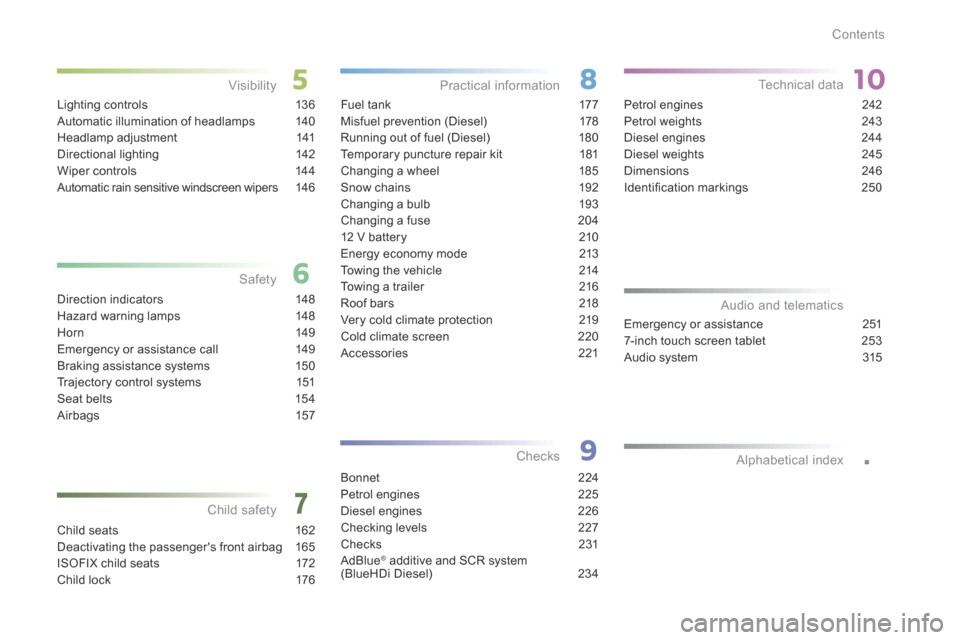
.
C5_en_Chap00a_sommaire_ed01-2015
Direction indicators 148
Hazard warning lamps 148
Hor n 149
Emergency or assistance call 149
Braking assistance systems 150
Trajectory control systems 151
Seat belts 154
Airbags 157Fuel tank
177
Misfuel prevention (Diesel) 178
Running out of fuel (Diesel) 180
Temporary puncture repair kit 181
Changing a wheel 185
Snow chains 192
Changing a bulb 193
Changing a fuse 204
12 V battery 210
Energy economy mode 213
Towing the vehicle 214
Towing a trailer 216
Roof bars 218
Very cold climate protection 219
Cold climate screen 220
a ccessories 221
Bonnet 224
Petrol engines 225
Diesel engines 226
Checking levels 227
Checks 231
ad blue
® additive and SCR system
(BlueHDi Diesel) 234Petrol engines
242
Petrol weights 243
Diesel engines 244
Diesel weights 245
Dimensions 246
Identification markings 250
Emergency or assistance 251
7-inch touch screen tablet 253
Audio system 315
Audio and telematics
Lighting controls 136
Automatic illumination of headlamps 140
Headlamp adjustment 141
Directional lighting 142
Wiper controls 144
Automatic rain sensitive windscreen wipers 14 6
Alphabetical index
Child safety Practical information
Checks
Visibility
Safety Technical data
Child seats
162
Deactivating the passenger's front airbag 165
ISOFIX child seats 172
Child lock 176
Contents
Page 13 of 366
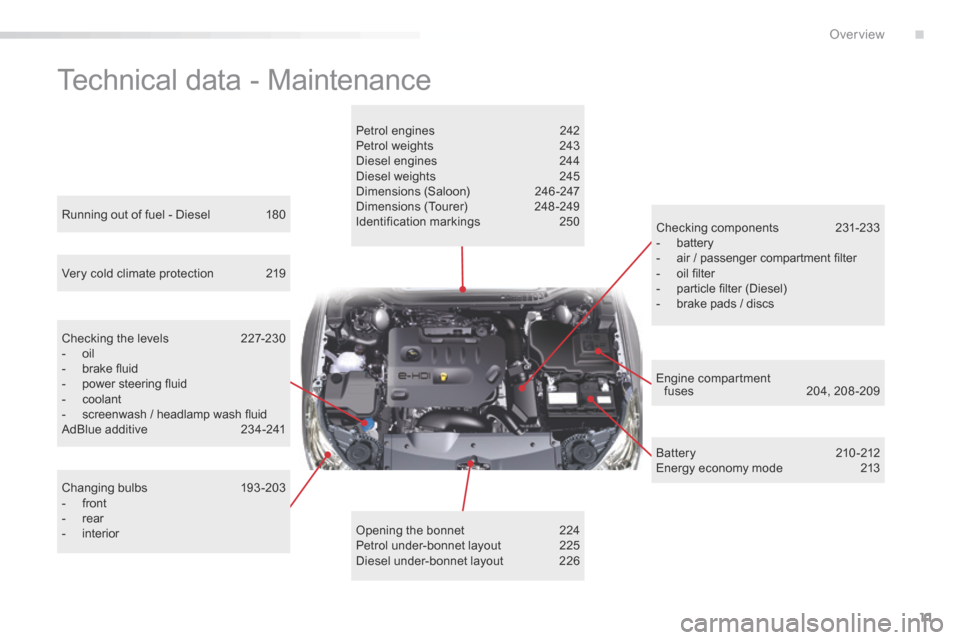
11
C5_en_Chap00b_vue-ensemble_ed01-2015
Technical data - Maintenance
Petrol engines 242
Petrol weights 243
Diesel engines 244
Diesel weights 245
Dimensions (Saloon) 246-247
Dimensions (Tourer) 248 -249
Identification markings 250
Opening the bonnet 224
Petrol under-bonnet layout 225
Diesel under-bonnet layout 226
Running out of fuel - Diesel
180
Checking the levels 227-230
- oil
- brake fluid
- power steering fluid
- coolant
- screenwash / headlamp wash fluid
AdBlue additive 234-241
Very cold climate protection
219
Changing bulbs 193-203
- front
- rear
- interior Checking components
231-233
- battery
- air / passenger compartment filter
- oil filter
- particle filter (Diesel)
- brake pads / discs
b atter y 210 -212
Energy economy mode 213
Engine compartment
fuses 204, 208 -209
.
over view
Page 15 of 366
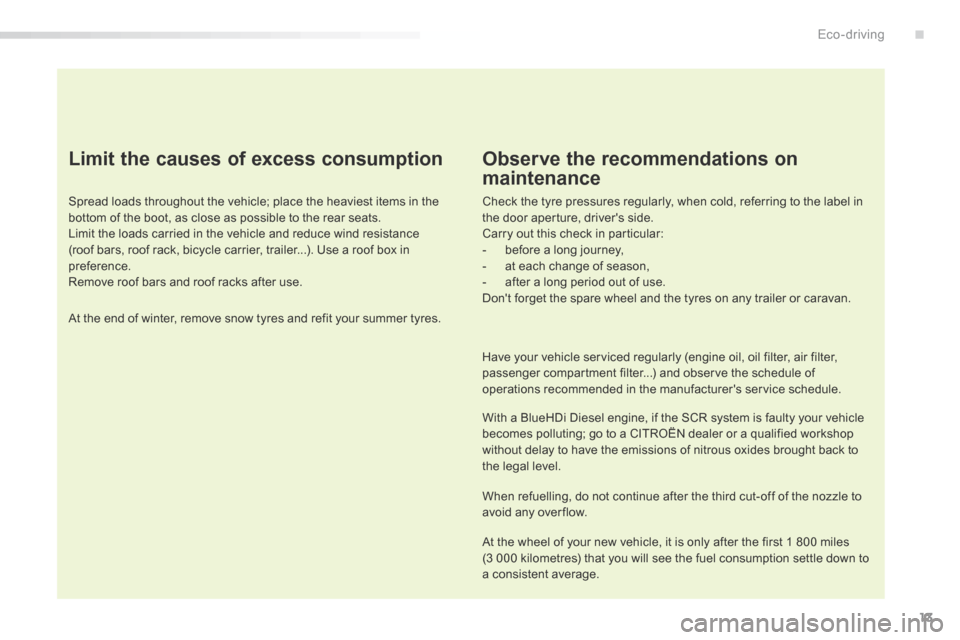
13
C5_en_Chap00c_eco-conduite_ed01-2015
Limit the causes of excess consumption
Spread loads throughout the vehicle; place the heaviest items in the
bottom of the boot, as close as possible to the rear seats.
Limit the loads carried in the vehicle and reduce wind resistance
(roof bars, roof rack, bicycle carrier, trailer...). Use a roof box in
preference.
Remove roof bars and roof racks after use.
At the end of winter, remove snow tyres and refit your summer tyres.
Observe the recommendations on
maintenance
Check the tyre pressures regularly, when cold, referring to the label in
the door aperture, driver's side.
Carry out this check in particular:
- before a long journey,
- at each change of season,
- after a long period out of use.
Don't forget the spare wheel and the tyres on any trailer or caravan.
Have your vehicle serviced regularly (engine oil, oil filter, air filter,
passenger compartment filter...) and observe the schedule of
operations recommended in the manufacturer's service schedule.
With a BlueHDi Diesel engine, if the SCR system is faulty your vehicle
becomes polluting; go to a CITROËN dealer or a qualified workshop
without delay to have the emissions of nitrous oxides brought back to
the legal level.
When refuelling, do not continue after the third cut-off of the nozzle to
avoid any over flow.
At the wheel of your new vehicle, it is only after the first 1 800 miles
(3 000 kilometres) that you will see the fuel consumption settle down to
a consistent average.
.
Eco-driving
Page 23 of 366
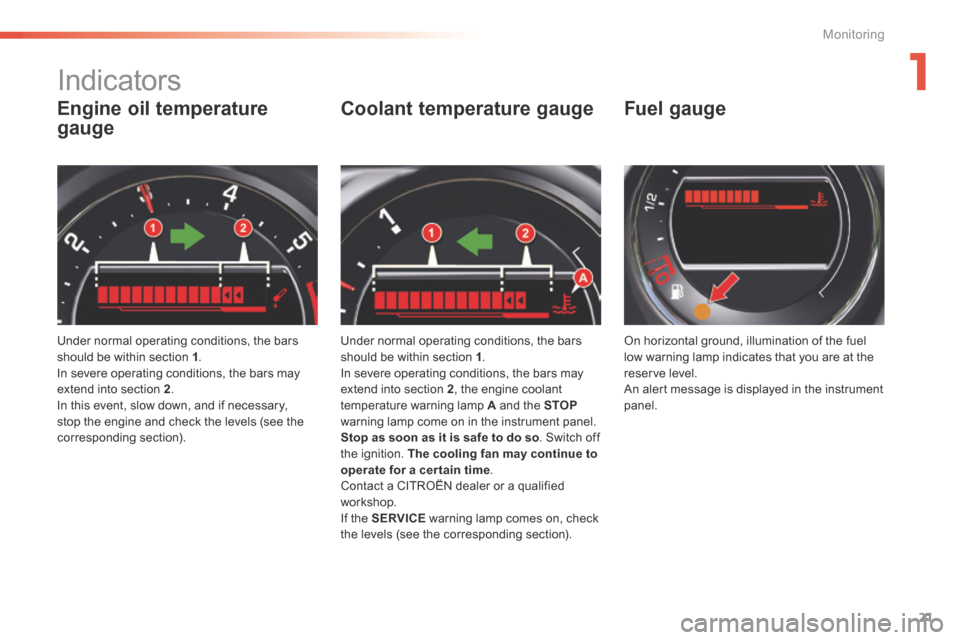
21
C5_en_Chap01_controle-de-marche_ed01-2015
Engine oil temperature
gauge
Under normal operating conditions, the bars
should be within section 1.
In severe operating conditions, the bars may
extend into section 2 .
In this event, slow down, and if necessary,
stop the engine and check the levels (see the
corresponding section).
Coolant temperature gauge
Under normal operating conditions, the bars
should be within section 1 .
In severe operating conditions, the bars may
extend into section 2 , the engine coolant
temperature warning lamp A and the STOP
warning lamp come on in the instrument panel.
Stop as soon as it is safe to do so . Switch off
the ignition. The cooling fan may continue to
operate for a cer tain time .
Contact a CITROËN dealer or a qualified
workshop.
If the SERVICE warning lamp comes on, check
the levels (see the corresponding section). On horizontal ground, illumination of the fuel
low warning lamp indicates that you are at the
reser ve level.
An alert message is displayed in the instrument
panel.
Fuel gauge
Indicators
1
Monitoring
Page 26 of 366
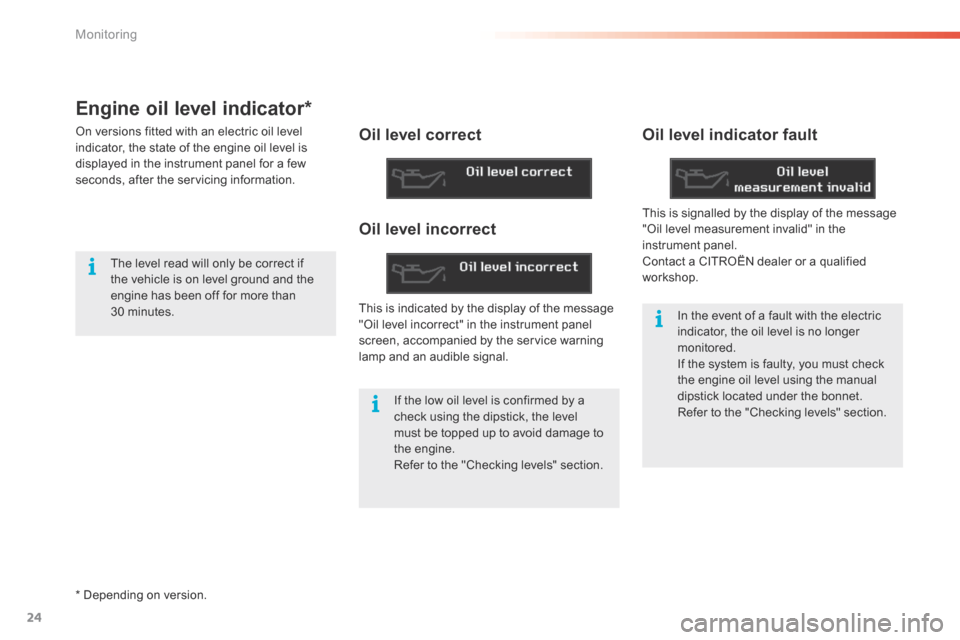
24
C5_en_Chap01_controle-de-marche_ed01-2015
Engine oil level indicator*
on versions fitted with an electric oil level
indicator, the state of the engine oil level is
displayed in the instrument panel for a few
seconds, after the servicing information.Oil level correct
This is indicated by the display of the message
"Oil level incorrect" in the instrument panel
screen, accompanied by the service warning
lamp and an audible signal.
Oil level indicator fault
* Depending on version. In the event of a fault with the electric
indicator, the oil level is no longer
monitored.
If the system is faulty, you must check
the engine oil level using the manual
dipstick located under the bonnet.
Refer to the "Checking levels" section.
Oil level incorrect
This is signalled by the display of the message
"Oil level measurement invalid" in the
instrument panel.
Contact a CITROËN dealer or a qualified
workshop.
If the low oil level is confirmed by a
check using the dipstick, the level
must be topped up to avoid damage to
the engine.
Refer to the "Checking levels" section.
The level read will only be correct if
the vehicle is on level ground and the
engine has been off for more than
30
minutes.
Monitoring
Page 31 of 366
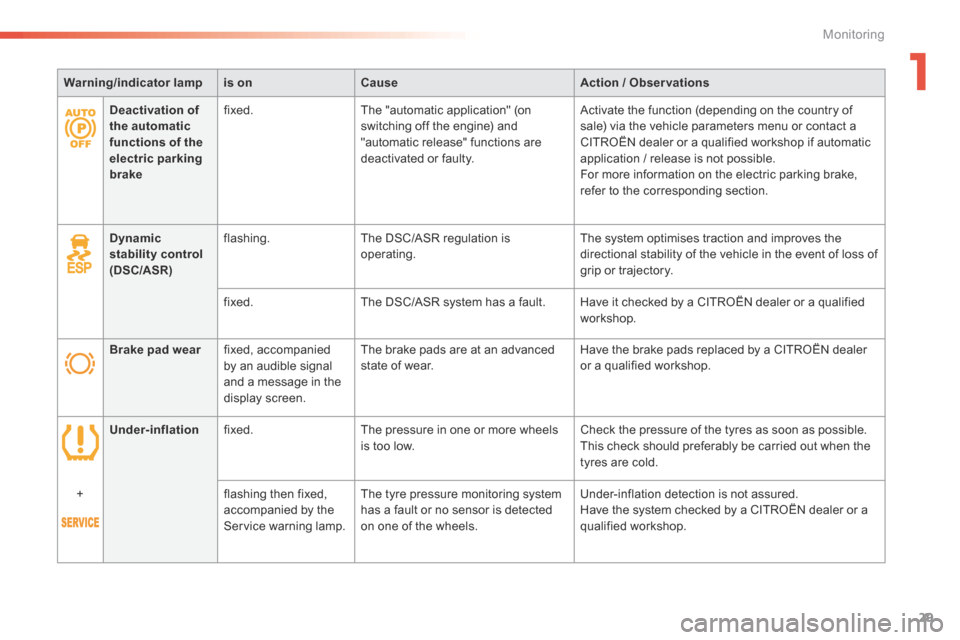
29
C5_en_Chap01_controle-de-marche_ed01-2015
Dynamic
stability control
(DSC/ASR) flashing.
The DSC/ASR regulation is
operating. The system optimises traction and improves the
directional stability of the vehicle in the event of loss of
grip or trajectory.
fixed. The DSC/ASR system has a fault. Have it checked by a CITROËN dealer or a qualified
workshop.
Warning
/indicator lampis on Cause Action / Observations
Brake pad wear fixed, accompanied
by an audible signal
and a message in the
display screen. The brake pads are at an advanced
state of wear.
Have the brake pads replaced by a CITROËN dealer
or a qualified workshop.
Deactivation of
the automatic
functions of the
electric parking
brake
fixed.
The "automatic application" (on
switching off the engine) and
"automatic release" functions are
deactivated or faulty. Activate the function (depending on the country of
sale) via the vehicle parameters menu or contact a
CITROËN dealer or a qualified workshop if automatic
application / release is not possible.
For more information on the electric parking brake,
refer to the corresponding section.
Under-inflation fixed. The pressure in one or more wheels
is too low. Check the pressure of the tyres as soon as possible.
This check should preferably be carried out when the
tyres are cold.
+ flashing then fixed,
accompanied by the
Service warning lamp.The tyre pressure monitoring system
has a fault or no sensor is detected
on one of the wheels. Under-inflation detection is not assured.
Have the system checked by a CITROËN dealer or a
qualified workshop.
1
Monitoring
Page 33 of 366
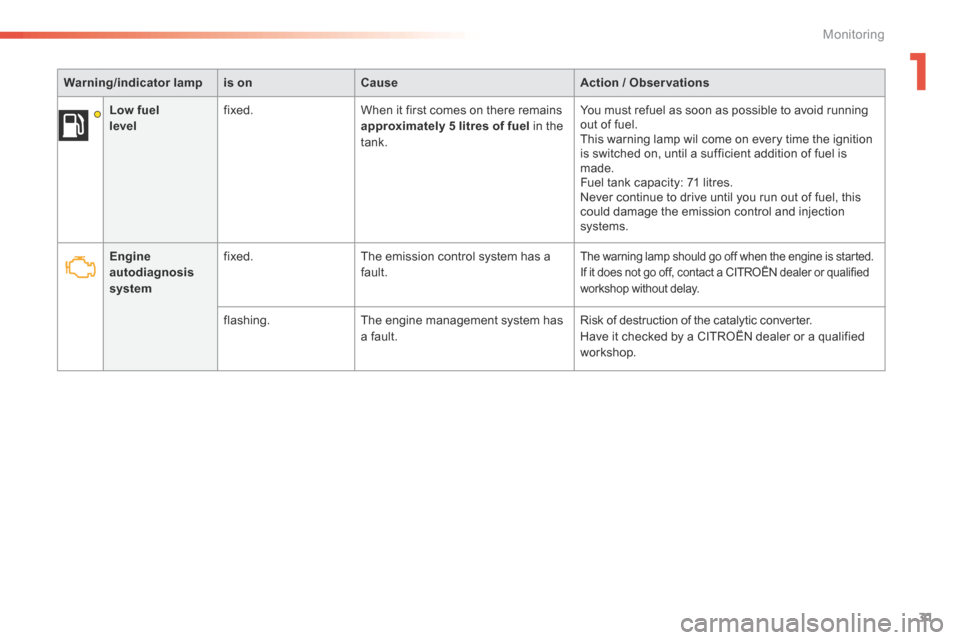
31
C5_en_Chap01_controle-de-marche_ed01-2015
Warning/indicator lampis on Cause Action / Observations
Engine
autodiagnosis
system fixed.
The emission control system has a
fault.
The warning lamp should go off when the engine is started.
If it does not go off, contact a CITROËN dealer or qualified
workshop without delay.
flashing.The engine management system has
a fault. Risk of destruction of the catalytic converter.
Have it checked by a CITROËN dealer or a qualified
workshop.
Low fuel
level
fixed.
When it first comes on there remains
approximately 5 litres of fuel in the
tank. You must refuel as soon as possible to avoid running
out of fuel.
This warning lamp wil come on every time the ignition
is switched on, until a sufficient addition of fuel is
made.
Fuel tank capacity: 71 litres.
n
ever continue to drive until you run out of fuel, this
could damage the emission control and injection
systems.
1
Monitoring
Page 51 of 366
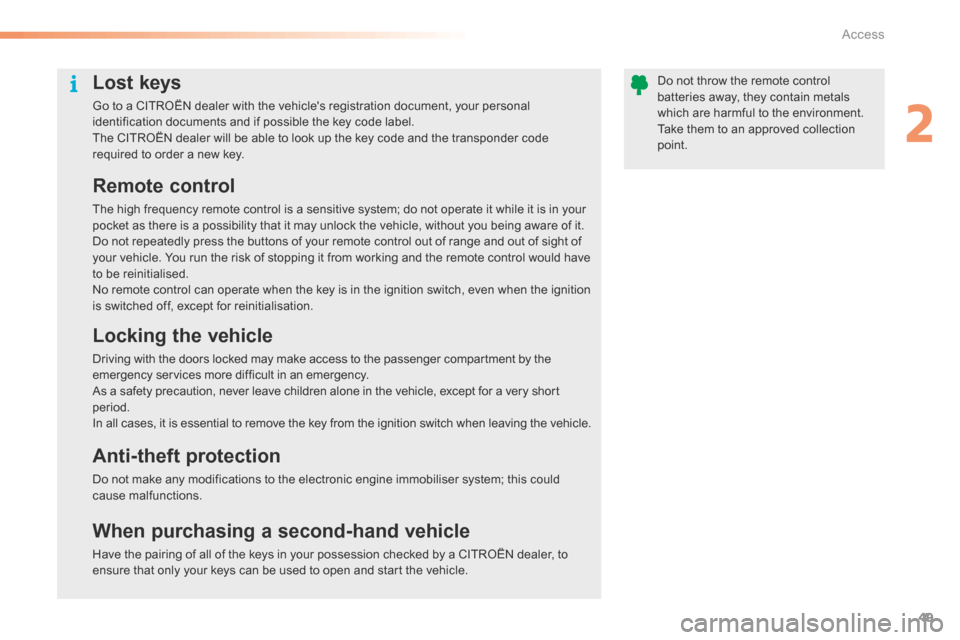
49
C5_en_Chap02_ouverture_ed01-2015
Lost keys
Go to a CITROËN dealer with the vehicle's registration document, your personal
identification documents and if possible the key code label.
The CITROËN dealer will be able to look up the key code and the transponder code
required to order a new key.
Remote control
The high frequency remote control is a sensitive system; do not operate it while it is in your
pocket as there is a possibility that it may unlock the vehicle, without you being aware of it.
Do not repeatedly press the buttons of your remote control out of range and out of sight of
your vehicle. You run the risk of stopping it from working and the remote control would have
to be reinitialised.
No remote control can operate when the key is in the ignition switch, even when the ignition
is switched off, except for reinitialisation.
Locking the vehicle
Driving with the doors locked may make access to the passenger compartment by the
emergency services more difficult in an emergency.
As a safety precaution, never leave children alone in the vehicle, except for a very short
period.
In all cases, it is essential to remove the key from the ignition switch when leaving the vehicle.
Anti-theft protection
Do not make any modifications to the electronic engine immobiliser system; this could
cause malfunctions.
When purchasing a second-hand vehicle
Have the pairing of all of the keys in your possession checked by a CITROËN dealer, to
ensure that only your keys can be used to open and start the vehicle.Do not throw the remote control
batteries away, they contain metals
which are harmful to the environment.
Take them to an approved collection
point.
2
access
Page 76 of 366
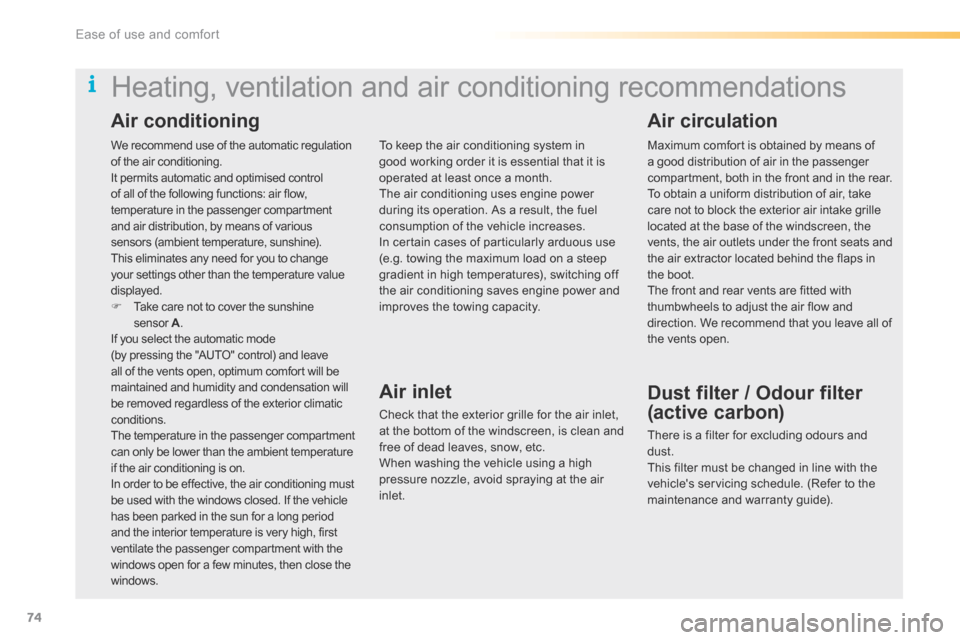
74
C5_en_Chap03_ergo-et-confort_ed01-2015
We recommend use of the automatic regulation
of the air conditioning.
It permits automatic and optimised control
of all of the following functions: air flow,
temperature in the passenger compartment
and air distribution, by means of various
sensors (ambient temperature, sunshine).
This eliminates any need for you to change
your settings other than the temperature value
displayed.
F Take care not to cover the sunshine
sensor A.
If you select the automatic mode
(by pressing the "AUTO" control) and leave
all of the vents open, optimum comfort will be
maintained and humidity and condensation will
be removed regardless of the exterior climatic
conditions.
The temperature in the passenger compartment
can only be lower than the ambient temperature
if the air conditioning is on.
In order to be effective, the air conditioning must
be used with the windows closed. If the vehicle
has been parked in the sun for a long period
and the interior temperature is very high, first
ventilate the passenger compartment with the
windows open for a few minutes, then close the
windows.
Heating, ventilation and air conditioning recommendations
To keep the air conditioning system in
good working order it is essential that it is
operated at least once a month.
The air conditioning uses engine power
during its operation. As a result, the fuel
consumption of the vehicle increases.
In certain cases of particularly arduous use
(e.g. towing the maximum load on a steep
gradient in high temperatures), switching off
the air conditioning saves engine power and
improves the towing capacity.
Air inlet
Check that the exterior grille for the air inlet,
at the bottom of the windscreen, is clean and
free of dead leaves, snow, etc.
When washing the vehicle using a high
pressure nozzle, avoid spraying at the air
inlet. Maximum comfort is obtained by means of
a good distribution of air in the passenger
compartment, both in the front and in the rear.
To obtain a uniform distribution of air, take
care not to block the exterior air intake grille
located at the base of the windscreen, the
vents, the air outlets under the front seats and
the air extractor located behind the flaps in
the boot.
The front and rear vents are fitted with
thumbwheels to adjust the air flow and
direction. We recommend that you leave all of
the vents open.
Dust filter / Odour filter
(active carbon)
There is a filter for excluding odours and
dust.
This filter must be changed in line with the
vehicle's servicing schedule. (Refer to the
maintenance and warranty guide).
Air conditioning
Air circulation
Ease of use and comfort
Page 98 of 366
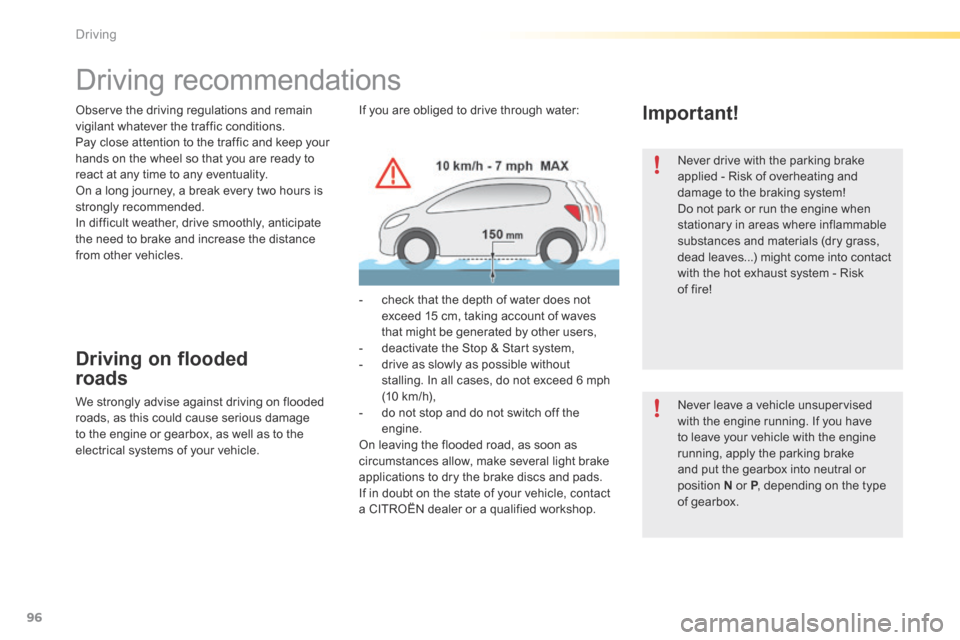
96
C5_en_Chap04_conduite_ed01-2015
Observe the driving regulations and remain
vigilant whatever the traffic conditions.
Pay close attention to the traffic and keep your
hands on the wheel so that you are ready to
react at any time to any eventuality.
On a long journey, a break every two hours is
strongly recommended.
In difficult weather, drive smoothly, anticipate
the need to brake and increase the distance
from other vehicles.
Driving on flooded
roads
We strongly advise against driving on flooded
roads, as this could cause serious damage
to the engine or gearbox, as well as to the
electrical systems of your vehicle.
Driving recommendations
Important!
Never drive with the parking brake
applied - Risk of overheating and
damage to the braking system!
Do not park or run the engine when
stationary in areas where inflammable
substances and materials (dry grass,
dead leaves...) might come into contact
with the hot exhaust system - Risk
of fire!
n ever leave a vehicle unsupervised
with the engine running. If you have
to leave your vehicle with the engine
running, apply the parking brake
and put the gearbox into neutral or
position N or P, depending on the type
of gearbox.
If you are obliged to drive through water:
-
check that the depth of water does not
exceed 15 cm, taking account of waves
that might be generated by other users,
- deactivate the Stop & Start system,
- drive as slowly as possible without
stalling. In all cases, do not exceed 6 mph
(10 km/h),
- do not stop and do not switch off the
engine.
On leaving the flooded road, as soon as
circumstances allow, make several light brake
applications to dry the brake discs and pads.
If in doubt on the state of your vehicle, contact
a CITROËN dealer or a qualified workshop.
driving